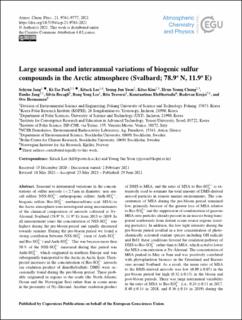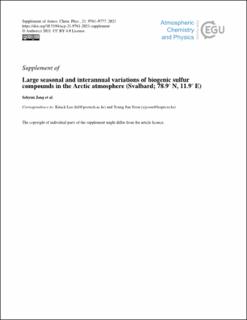| dc.contributor.author | Jang, Sehyun | |
| dc.contributor.author | Park, Ki-Tae | |
| dc.contributor.author | Lee, Kitack | |
| dc.contributor.author | Yoon, Young Jun | |
| dc.contributor.author | Kim, Kitae | |
| dc.contributor.author | Chung, Hyun Young | |
| dc.contributor.author | Jang, Eunho | |
| dc.contributor.author | Becagli, Silvia | |
| dc.contributor.author | Lee, Bang Young | |
| dc.contributor.author | Traversi, Rita | |
| dc.contributor.author | Eleftheriadis, Konstantinos | |
| dc.contributor.author | Krejci, Radovan | |
| dc.contributor.author | Hermansen, Ove | |
| dc.date.accessioned | 2021-08-20T12:34:26Z | |
| dc.date.available | 2021-08-20T12:34:26Z | |
| dc.date.created | 2021-08-18T10:51:00Z | |
| dc.date.issued | 2021 | |
| dc.identifier.citation | Atmospheric Chemistry and Physics. 2021, 21, 9761-9777. | en_US |
| dc.identifier.issn | 1680-7316 | |
| dc.identifier.uri | https://hdl.handle.net/11250/2770587 | |
| dc.description.abstract | Seasonal to interannual variations in the concentrations of sulfur aerosols (< 2.5 µm in diameter; non sea-salt sulfate: NSS-SO2−4; anthropogenic sulfate: Anth-SO2−4; biogenic sulfate: Bio-SO2−4; methanesulfonic acid: MSA) in the Arctic atmosphere were investigated using measurements of the chemical composition of aerosols collected at Ny-Ålesund, Svalbard (78.9∘ N, 11.9∘ E) from 2015 to 2019. In all measurement years the concentration of NSS-SO2−4 was highest during the pre-bloom period and rapidly decreased towards summer. During the pre-bloom period we found a strong correlation between NSS-SO2−4 (sum of Anth-SO2−4 and Bio-SO2−4) and Anth-SO2−4. This was because more than 50 % of the NSS-SO2−4 measured during this period was Anth-SO2−4, which originated in northern Europe and was subsequently transported to the Arctic in Arctic haze. Unexpected increases in the concentration of Bio-SO2−4 aerosols (an oxidation product of dimethylsulfide: DMS) were occasionally found during the pre-bloom period. These probably originated in regions to the south (the North Atlantic Ocean and the Norwegian Sea) rather than in ocean areas in the proximity of Ny-Ålesund. Another oxidation product of DMS is MSA, and the ratio of MSA to Bio-SO2−4 is extensively used to estimate the total amount of DMS-derived aerosol particles in remote marine environments. The concentration of MSA during the pre-bloom period remained low, primarily because of the greater loss of MSA relative to Bio-SO2−4 and the suppression of condensation of gaseous MSA onto particles already present in air masses being transported northwards from distant ocean source regions (existing particles). In addition, the low light intensity during the pre-bloom period resulted in a low concentration of photochemically activated oxidant species including OH radicals and BrO; these conditions favored the oxidation pathway of DMS to Bio-SO2−4 rather than to MSA, which acted to lower the MSA concentration at Ny-Ålesund. The concentration of MSA peaked in May or June and was positively correlated with phytoplankton biomass in the Greenland and Barents seas around Svalbard. As a result, the mean ratio of MSA to the DMS-derived aerosols was low (0.09 ± 0.07) in the pre-bloom period but high (0.32 ± 0.15) in the bloom and post-bloom periods. There was large interannual variability in the ratio of MSA to Bio-SO2−4 (i.e., 0.24 ± 0.11 in 2017, 0.40 ± 0.14 in 2018, and 0.36 ± 0.14 in 2019) during the bloom and post-bloom periods. This was probably associated with changes in the chemical properties of existing particles, biological activities surrounding the observation site, and air mass transport patterns. Our results indicate that MSA is not a conservative tracer for predicting DMS-derived particles, and the contribution of MSA to the growth of newly formed particles may be much larger during the bloom and post-bloom periods than during the pre-bloom period. | en_US |
| dc.language.iso | eng | en_US |
| dc.rights | Navngivelse 4.0 Internasjonal | * |
| dc.rights.uri | http://creativecommons.org/licenses/by/4.0/deed.no | * |
| dc.title | Large seasonal and interannual variations of biogenic sulfur compounds in the Arctic atmosphere (Svalbard; 78.9° N, 11.9° E) | en_US |
| dc.type | Peer reviewed | en_US |
| dc.type | Journal article | en_US |
| dc.description.version | publishedVersion | en_US |
| dc.rights.holder | © Author(s) 2021. | en_US |
| dc.source.pagenumber | 9761-9777 | en_US |
| dc.source.volume | 21 | en_US |
| dc.source.journal | Atmospheric Chemistry and Physics | en_US |
| dc.identifier.doi | 10.5194/acp-21-9761-2021 | |
| dc.identifier.cristin | 1926881 | |
| cristin.ispublished | true | |
| cristin.fulltext | original | |
| cristin.qualitycode | 2 | |


